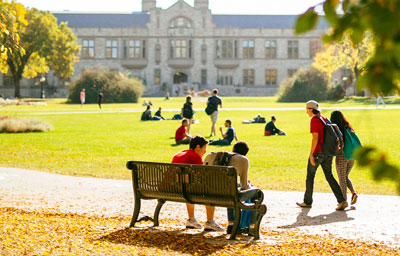About
Statistics is the science of learning from data. Statisticians can analyze and draw practical conclusions from data and provide crucial guidance in determining what information is reliable and which predictions can be trusted. Many economic, social, political, and military decisions cannot be made without statistical techniques.
- Four year degree
- Full or part-time program
- You can enter this program directly from high school
- You can begin this program off-campus
What you will learn
You will study principles of experimental design and methods for data collection, analysis and interpretation.
A first-year schedule sample
This degree program is flexible and offers you the opportunity to take courses in many different subject areas. Here’s what a typical first-year schedule might look like:
| Course | Description |
|---|---|
Fall Term |
|
| MATH 110 or MATH 176a | Calculus I or Advanced Calculus I (for students with Calculus 30) |
| CMPT 141a | Introduction to Computer Science |
| MATH 164a | Introduction to Linear Algebra |
| ENG 113b | Literature and Composition Reading Narrative |
| INDG 107c | Introduction to Canadian Indigenous Studies |
Winter Term |
|
| MATH 116 or MATH 177a | Calculus II or Advanced Calculus II |
| CMPT 145a | Principles of Computer Science |
| MATH 163a | Introduction to Mathematical Reasoning |
| PHIL 120b | Knowledge Mind and Existence |
a Required course for the major
b One of the course options to complete the English Language Writing Requirement
c One of the course options to complete the Indigenous Learning Requirement
d One of the course options which may be used in the Breadth Requirement
The Course and Program Catalogue has the complete and official listing of required classes and their descriptions for this program.
STAT 244: Elementary Statistical Concepts
Statistical concepts and techniques including graphing of distributions, measures of location and variability, measures of association, regression, probability, confidence intervals, hypothesis testing. Students should consult with their department before enrolling in this course to determine the status of this course in their program.
STAT 344: Applied Regression Analysis
Applied regression analysis involving the extensive use of computer software. Includes: linear regression; multiple regression; stepwise methods; residual analysis; robustness considerations; multicollinearity; biased procedures; non-linear regression.
STAT 442: Statistical Inference
Parametric estimation, maximum likelihood estimators, unbiased estimators, UMVUE, confidence intervals and regions, tests of hypotheses, Neyman Pearson Lemma, generalized likelihood ratio tests, chi-square tests, Bayes estimators.
Unique opportunities
You will have the opportunity to interact with researchers in statistics, mathematics, health and medical sciences and the national and international statistical and mathematical science communities. The Department participates annually in undergraduate mathematical competitions that expose students to situations with no classroom counterpart.
Student-professor ratios
Upper year classes have excellent student-professor ratios; this allows for direct interaction and creates an excellent learning environment.
Careers
One advantage of working in statistics is that you can combine your interest with almost any other field in science, technology or business.
Numerous industries employ statisticians:
- Health and Medicine: animal health, biostatistics, clinical trails, epidemiology, genetics, pharmacology, public health.
- Business and Industry: actuary, agriculture, computer science, economics, engineering, finance, insurance, marketing, quality improvement, reliability.
- Government: census, ecology, environment, forestry, government regulation, population research, risk assessment, surveys.
Tuition estimates
| Canadian students | International students | |
|---|---|---|
| Tuition | $8,205 | $39,711 |
| Student fees | $1,308.24 | $1,308.24 |
| Books | $1,500 | $1,500 |
| Total | $11,013.24 | $42,519.24 |
Tuition will vary depending on the type and number of classes you take in a year. This estimate reflects a typical amount you could expect to pay in your first year if you enroll in a full course load, the maximum number of courses allowed (2025–2026 Canadian dollar rates).
Student fees are used to fund specific student benefits, including health, vision and dental coverage, a bus pass, recreational programs and fitness centre access.
The cost of books and supplies varies widely depending on the courses you choose. It is recommended that you budget between $1,500–$2,500 per year.
Program options

These Bachelor of Science (B.Sc.) Statistics degrees are offered by the University of Saskatchewan's College of Arts and Science:
You should consult with an academic advisor in the college when you begin your studies to decide if you want a four-year or honours degree.
Admission requirements
Your information
Admission requirements depend on your situation; please tell us about yourself.
Application deadlines
| Start term | Application deadline | International deadline |
|---|---|---|
|
Winter January 2026 |
Dec. 1, 2025 Documents due: Dec. 15, 2025 |
Sept. 1, 2025 Documents due: Oct. 1, 2025 |
|
Spring May 2026 |
April 1, 2026 Documents due: May 1, 2026 |
Feb. 1, 2026 Documents due: March 1, 2026 |
|
Summer July 2026 |
May 1, 2026 Documents due: June 1, 2026 |
March 1, 2026 Documents due: April 1, 2026 |
|
Fall September 2026 |
July 15, 2026 Documents due: Aug. 1, 2026 |
May 1, 2026 Documents due: June 1, 2026 |
|
Winter January 2027 |
Dec. 1, 2026 Documents due: Dec. 15, 2026 |
Sept. 1, 2026 Documents due: Oct. 1, 2026 |
Ready to apply?
Create an admissions account and start your application today. When you are ready to submit your application, you will be assessed a non-refundable application fee of $120 CAD.
Related programs
If you are looking for graduate level (master's or Ph.D.) programs please consult our graduate students' website.

Stay connected
Do you want us to send you important reminders, information about our programs or notifications about USask events?

